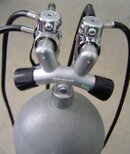ucfdiver
Contributor
Can someone post a photo or description of using a H valve setup? I need one for an upcoming course, and would like to know ahead of time how it's setup so I can go ahead and purchase it and do a few practice dives with it.
So far from what I understand, I need-
2 1st stages
primary and secondary 2nd stage
secondary 2nd stage on a 7/8ft hose
air gauge
Any help would be appreciated.
So far from what I understand, I need-
2 1st stages
primary and secondary 2nd stage
secondary 2nd stage on a 7/8ft hose
air gauge
Any help would be appreciated.






